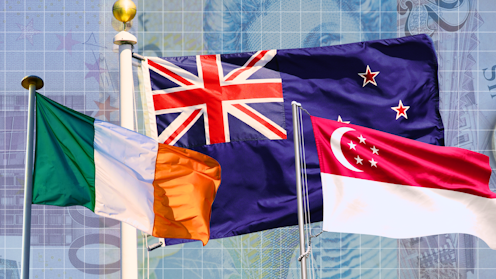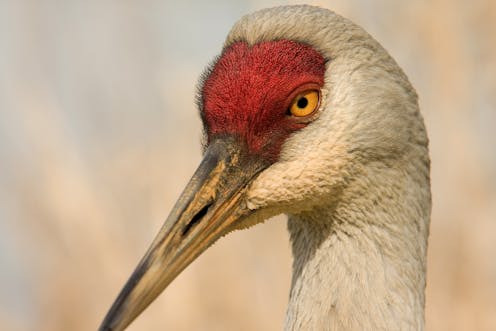Tiny marine plants face a mixed bag thanks to climate change
 Phytoplankton are responsible for half the world's productivity. Here, a phytoplankton bloom in the northern Pacific. NASA Goddard Space Flight Center/Flickr, CC BY
Phytoplankton are responsible for half the world's productivity. Here, a phytoplankton bloom in the northern Pacific. NASA Goddard Space Flight Center/Flickr, CC BYYou may not have heard of them or given them much thought, but phytoplankton — the microscopic plants that grow throughout the world’s oceans — are the foundation of oceanic food webs.
Although tiny, they are responsible for half of the productivity of the planet, and through photosynthesis are a source of energy for virtually all marine ecosystems and the fisheries that many people depend on.
So it’s important to know how climate change might affect them.
In a new study published in Nature Climate Change, my colleagues and I have mapped out the environmental factors the influence phytoplankton, and how they might change due to global warming.
There’s good news and bad news, but the new models will help scientists better figure out how phytoplankton, and the ecosystems that depend on them, will be affected by climate change.
Why phytoplankton are important
 Three different types of phytoplankton: dinoflagellates (top), diatoms (middle), and cyanobacteria (bottom)Professor Gustaaf Hallegraeff (IMAS)
Three different types of phytoplankton: dinoflagellates (top), diatoms (middle), and cyanobacteria (bottom)Professor Gustaaf Hallegraeff (IMAS)
Apart from an energy supply, the different types of phytoplankton provide a range of services in the ocean.
For example, nitrogen-fixing phytoplankton play a similar role to legumes in the soil. They directly fix atmospheric nitrogen in the ocean, and so can enhance stocks of important nutrients.
Others such as diatoms are large and sink rapidly because they have heavy armoured shells called frustules. This means that they sink carbon into the deep ocean, and influence the amount of CO2 in the air.
Heating up
Currently, thanks to rising levels of greenhouse gases, we’re seeing unprecedentedly rapid changes in the world’s oceans.
There are a number of environmental factors which are very important to phytoplankton. Obviously temperature will influence their growth rate and many of their physiological processes. Light levels are very important for photosynthesis.
So is the supply of nutrients such as phosphate, nitrate, and trace elements such as iron, which is essential for the enzyme systems of phytoplankton. CO2 is also vital as a source of carbon in photosynthesis.
One of the most important outcomes of this study is that it reveals that many of these biologically influential factors will be changing at the same time. Hence it’s important to look beyond previous studies that have focused solely on the effect of warming or acidifying the ocean on different types of phytoplankton.
This study doesn’t just look at these environmental factors, it also looks at the interactions between them. For example as we warm the ocean, we decrease its ability to hold onto CO2 which will then indirectly influence the amount of acidification.
Isn’t CO2 good for plants?
On land there’s considerable uncertainty about how rising CO2 will affect plants. On the one hand, the rate of photosynthesis increases as CO2 levels rise (and possibly more than we thought). But on the other hand, plants also need other factors to grow such as water, which may become more scarce in a changing climate.
It’s a similar story in the oceans. Rising CO2 has complex effects in the ocean, such as increasing acidity. We’ve already seen decreasing pH (ocean acidification) with high CO2.
We’ve observed that ocean acidification can dissolve a group of phytoplankton called coccolithophores. But we’ve also seen positive effects on nitrogen-fixing phytoplankton, where the growth rate and amount of nitrogen fixed increases with increasing carbon dioxide.
So some phytoplankton groups, and even subgroups within them, will thrive under higher CO2 conditions. Other groups will encounter detrimental effects. We have to tease these apart, but it’s not necessarily a doom and gloom message.
A climate road map
There have been prior modelling studies from France which show that the productivity of the low latitudes of the tropics and subtropics will probably decrease, while the productivity of the high latitudes, such as the sub-antarctic waters and Southern Ocean will increase. But those projections are only as good as the model structure they use, which in this case focused primarily on warming and ocean acidification.
So in our study we’ve developed a road map from the polar to the tropical regions. We can then use these model projections to compare these regional signatures to the global mean oceanic response to a changing climate. In some studies for example we see that warming and a change in iron supply will enhance growth, in other cases environmental changes will decrease growth.
If we were to see a 20% decrease in productivity in the subtropical and tropical oceans and an increase at high latitudes that has big implications for food security, and for how other ecosystems might respond. Nailing that down as best we can is the goal of our research.
Philip Boyd does not work for, consult to, own shares in or receive funding from any company or organisation that would benefit from this article, and has no relevant affiliations.
Read more http://theconversation.com/tiny-marine-plants-face-a-mixed-bag-thanks-to-climate-change-34869
















